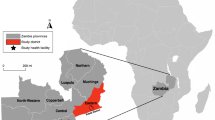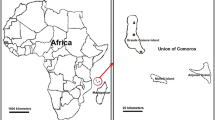Abstract
The goal of the present study was to assess the evolution of the in vitro chloroquine resistance and also the prevalence of pfcrt T76 and pfmdr1 Y86 mutations in Pikine from 2000 while chloroquine (CQ) was the first-line treatment of malaria to 2009 when artemisinin-based combination therapies (ACTs) are in use. We genotyped pfcrt K76T and pfmdr1 N86Y polymorphisms by PCR-RFLP and assessed in vitro CQ susceptibility by double-site enzyme-linked pLDH immunodetection (DELI) assay in Plasmodium falciparum isolates collected in Pikine, Senegal. The proportions of the pfcrt T76 allele in the light of the three different treatment policies were 72.4 % before CQ withdrawal (2000 to 2003), 47.2 % while amodiaquine plus Fansidar was the first-line treatment (2004 to 2005), and 59.5 % since the ACT use was implemented (2006 to 2009). The prevalence of pfcrt T76 decreased significantly after CQ was stopped [X 2 = 6.54, P = 0.01 (2000–2003 versus 2004–2005)] and then slightly since ACTs have been implemented [X 2 = 1.12, P = 0.28 (2000–2003 versus 2006–2009)]. There were no significant differences on the prevalence of pfmdr1 Y86 throughout the three treatment policies. The DELI assay was carried out episodically in 2000 (n = 36), 2001 (n = 47), and 2009 (n = 37). The mean IC50s of the isolates to CQ in 2000 versus 2009 and 2001 versus 2009 are significantly different (P < 0.05). The Fisher exact test found a significant association between the presence of the pfcrt T76 mutant allele and in vitro resistance in 2000/2001 (P = 0.023), while in 2009 there were no association between both variables (P = 0.274). Mutant pfcrt T76 and pfmdr1 Y86 alleles and in vitro CQ-resistant strains are still circulating in Pikine. The official discontinuation of CQ use is not completely followed by its total withdrawal from private drug sellers, and the molecule still exerts pressure on local P. falciparum populations.

Similar content being viewed by others
References
Adagu IS, Warhurst C (2001) Plasmodium falciparum: linkage disequilibrium between loci in chromosomes 7 and 5 and chloroquine selective pressure in Northern Nigeria. Parasitology 123:219–224
Alker AP, Lim P, Sem R, Shah NK, Yi P, Bouth DM, Tsuyuoka R, Maguire JD, Fandeur T, Ariey F, Wongsrichanalai C, Meshnick SR (2007) Pfmdr1 and in vivo resistance to artesunate mefloquine in falciparum malaria in the Cambodian–Thai border. AmJTrop Med Hyg 76:641–647
Basco LK, Ringwald P (2000) Molecular epidemiology of malaria in Yaounde, Cameroon. VI. Sequence variations in the Plasmodium falciparum dihydrofolate reductase-thymidylate synthase gene and in vitro resistance to pyrimethamine and cycloguanil. AmJTrop Med Hyg 62:271–276
Djimde A, Doumbo OK, Cortese JF, Kayentao K, Doumbo S, Diourte Y, Dicko A, Su XZ, Nomura T, Fidock DA, Wellems TE, Plowe CV (2001) A molecular marker for chloroquine-resistant falciparum malaria. N Engl J Med 344:257–263
Dokomajilar C, Lankoande ZM, Dorsey G, Zongo I, Ouedraogo JB, Rosenthal PJ (2006) Roles of specific Plasmodium falciparum mutations in resistance to amodiaquine and sulfadoxine–pyrimethamine in Burkina Faso. AmJTrop Med Hyg 75:162–165
Dondorp A, Nosten F, Yi P, Das D, Phyo AP, Tarning JT, Lwin KM, Ariey M, Hanpithakpong W, Lee SJ, Ringwald P, Silamut K, Imwong M, Chotivanich K, Lim P, Herdman T, An SS, Yeung S, Singhasivanon P, Day NP, Lindergardh N, Socheat D, White NJ (2009) Artemisinin resistance in Plasmodium falciparum malaria. N Engl J Med 361:455–467
Duraisingh MT, Drakeley CJ, Muller O, Bailey R, Snounou G, Targett GAT, Greenwood BM, Warhurst DC (1997) Evidence for selection for the tyrosine-86 allele of the pfmdr 1 gene of Plasmodium falciparum by chloroquine and amodiaquine. Parasitology 114:205–211
Faye B, Ndiaye JL, Ndiaye D, Dieng Y, Faye O, Gaye O (2007) Efficacy and tolerability of four antimalarial combinations in the treatment of uncomplicated Plasmodium falciparum malaria in Senegal. Malar J 6:80
Fidock DA, Nomura T, Talley AK, Cooper RA, Dzekunov SM, Ferdig MT, Ursos LM, Sidhu AB, Naude B, Deitsch KW, Su XZ, Wootton JC, Roepe PD, Wellems TE (2000) Mutations in the Plasmodium falciparum digestive vacuole transmembrane protein pfCRT and evidence for their role in chloroquine resistance. Mol Cell 6:861–871
Gaye O, Bah IB, Diallo S, Victorius A, Bengua E, Faye O (1990) The emergence of chloroquine-resistant malaria in Dakar, Senegal. Ann Soc Belg Med Trop 70:33–37
Gaye O, Babou I, Faye O, Fall A, Molez JF, Bah IB, Diallo S (1993) Malaria morbidity and therapeutic efficacy of antimalarials. Study conducted in the region of Dakar. Med Trop 53:479–485
Griffing S, Syphard L, Sridaran S, McCollum AM, Mixson-Hayden T, Vinayak S, Villegas L, Barnwell JW, Escalante AA, Udhayakumar V (2010) Pfmdr1 amplification and fixation of pfcrt chloroquine resistance alleles in Plasmodium falciparum in Venezuela. Antimicrob Agents Chemother 54:1572–1579
Happi CT, Gbotosho GO, Folarin OA, Sowunmi A, Bolaji OM, Fateye BA, Kyle DE, Milhous W, Wirth DF, Oduola AM (2006) Linkage disequilibrium between two distinct loci in chromosome 5 and 7 of Plasmodium falciparum and in vivo chloroquine resistance in Southwest Nigeria. Parasitol Res 100:141–148
Holmgren G, Gil JP, Ferreira PM, Veiga MI, Obonyo CO, Bjorkman A (2006) Amodiaquine resistant Plasmodium falciparum malaria in vivo is associated with selection of pfcrt 76T and pfmdr1 86Y. Infect Genet Evol 6:309–314
Holmgren G, Hamrin J, Svard J, Martensson A, Gil JP, Bjorkman A (2007) Selection of pfmdr1 mutations after amodiaquine monotherapy and amodiaquine plus artemisinin therapy in East Africa. Infect Genet Evol 7:562–569
Isozumi R, Uemura H, Le DD, Truong VH, Nguyen DG, Ha VV, Bui QP, Nguyen VT, Nakazawa S (2010) Longitudinal survey of Plasmodium falciparum infection in Vietnam: characteristics of antimalarial resistance and their associated factors. J Clin Microbiol 48:70–77
Krogstad DJ, Gluzman IY, Kyle DE, Oduala AM, Martin SK, Milhous WK, Schlesinger PH (1987) Efflux of chloroquine from Plasmodium falciparum: mechanism of chloroquine resistance. Science 238:1283–1285
Kublin JG, Cortese JF, Njunju EM, Mukadam AG, Wirima JJ, Kazembe PN, Djimde AA, Kouriba B, Taylor TE, Plowe CV (2003) Reemergence of chloroquine-sensitive Plasmodium falciparum malaria after cessation of chloroquine use in Malawi. J Infect Dis 187:1870–1875
Laufer MK, Thesing PC, Eddington ND, Masonga R, Dzinjalamala FK, Takala SL, Taylor TE, Plowe CV (2006) Return of chloroquine antimalarial efficacy in Malawi. N Engl J Med 355:1959–1966
Manirakiza A, Njuimo SP, Le Faou A, Malvy D, Millet P (2010) Availability of antimalarial drugs and evaluation of the attitude and practices for the treatment of uncomplicated malaria in Bangui, Central African Republic. J Trop Med 2010:510834
Mita T, Kaneko A, Lum KJ, Bwijo B, Takechi M, Zungu IL, Tsukahara T, Tanabe K, Kobayakawa T, Bjorkman A (2003) Recovery of chloroquine sensitivity and low prevalence of the Plasmodium falciparum chloroquine resistance transporter gene mutation K76T following the discontinuance of chloroquine use in Malawi. AmJTrop Med Hyg 68:413–415
Moreno A, Brasseur P, Cuzin-Ouattara N, Blanc C, Druilhe P (2001) Evaluation under field conditions of the colorimetric DELI-microtest for the assessment of Plasmodium falciparum drug resistance. Trans R Soc Trop Med Hyg 95:100–103
Mwai L, Ochong E, Abdirahman A, Kiara SM, Ward S, Kokwaro G, Sasi P, March K, Borrman S, Mackinnon M, Nzila A (2009) Chloroquine resistance before and after its withdrawal in Kenya. Malar J 8:106
Ndiaye D, Patel V, Demas A, LeRoux M, Mboup S, Ndir O, Clardy J, Lakshmanan V, Daily JP, Wirth DF (2010) A non-radioactive DAPI-based high throughput in vitro assay to assess Plasmodium falciparum responsiveness to antimalarials increased sensitivity of P. falciparum to chloroquine in Senegal. AmJTrop Med Hyg 82:228–230
Noedl H, Socheat D, Satimai W (2009) Artemisinin-resistant malaria in Asia. N Engl J Med 36:540–541
Noranate R, Durand R, Tall A, Marama L, Spiegel A, Sokhna C, Pradines B, Cojean S, Guillotte M, Bischoff E, Ekala MT, Bouchier C, Fandeur T, Ariey F, Patarapotikul J, Lebras J, Trape JF, Rogier C, Mercereau-Puijalon O (2007) Rapid dissemination of Plasmodium falciparum drug resistance despite strictly controlled antimalarial use. PLoS One 2(1):e139
Pussard E, Verdier F, Faurisson F, Scherrmann JM, Le Bras J, Blayo MC (1987) Disposition of monodesethylamodiaquine after a single oral dose of amodiaquine and three regimens forprophylaxis against Plasmodium falciparum malaria. Eur J Clin Pharmacol 33:409–414
Reed MB, Saliba KJ, Caruana SR, Kirk K, Cowman AF (2000) Pgh1 modulates sensitivity and resistance to multiple antimalarials in Plasmodium falciparum. Nature 403:906–909
Sarr O, Myrick A, Daily JP, Diop BM, Dieng T, Ndir O, Sow PS, Mboup S, Wirth DF (2005) In vivo and in vitro analysis of chloroquine resistance in Plasmodium falciparum isolates from Senegal. Parasitol Res 97:136–140
Sarr O, Ahouidi A, Daily J, Ly O, Ndiaye D, Dieng T, Ndir O, Mboup S, Wirth DF (2008) Mutations in pfcrt K76T do not correlate with sulfadoxine pyrimethamine amodiaquine failure in Pikine, Senegal. Parasitol Res 103:765–769
Schwenke A, Brandts C, Philipps J, Winkler S, Werndorfer WH, Kremsner PG (2001) Declining chloroquine resistance of Plasmodium falciparum in Lambarene, Gabon from 1992 to 1998. Wien Klin Wochenschr 113:63–64
Sisowath C, Stromberg J, Martensson A, Msellem M, Obondo C, Bjorkman A, Gil JP (2005) In vivo selection of Plasmodium falciparum pfmdr1 86N coding alleles by artemether–lumefantrine (Coartem). J Infect Dis 191:1014–1017
Sisowath C, Petersen I, Veiga MI, Mårtensson A, Premji Z, Björkman A, Fidock DA, Gil JP (2009) In vivo selection of Plasmodium falciparum parasites carrying the chloroquine-susceptible pfcrt K76 allele after treatment with artemether–lumefantrine in Africa resistance to lumefantrine might be caused by the extended elimination half-life of the molecule. J Infect Dis 199:750–757
Smith LA, Bruce J, Gueye L, Helou A, Diallo R, Gueye B, Jones C, Webster J (2010) From fever to anti-malarials: the treatment seeking-process in rural Senegal. Malar J 9:333
Sokhna CS, Molez JF, Ndiaye P, Sane B, Trape JF (1997) In vivo chemosensitivity tests of Plasmodium falciparum to chloroquine in Senegal: the development of resistance and the assessment of therapeutic efficacy. Bull Soc Pathol Exot 90:83–89
Some AF, Sere YY, Dokomajilar C, Zongo I, Rouamba N, Greenhouse B, Ouedraogo JB, Rosenthal PJ (2010) Selection of known Plasmodium falciparum resistance-mediating polymorphisms by artemether–lumefantrine and amodiaquine–sulfadoxine–pyrimethamine but not dihydroartemisinin–piperaquine in Burkina Faso. Antimicrob Agents Chemother 54:1949–1954
Thomas MT, Ndir O, Dieng T, Mboup S, Wypij D, Maguire JH, Wirth DF (2002) In vitro chloroquine susceptibility and PCR analysis of Pfcrt and Pfmdr1 polymorphisms in Plasmodium falciparum isolates from Senegal. AmJTrop Med Hyg 66:474–480
Trape JF, Legros F, Ndiaye P, Konate L, Bah IB, Diallo S, Verdier F, Hatin I, Le Bras J (1989) Chloroquine-resistant Plasmodium falciparum malaria in Senegal. Trans R Soc Trop Med Hyg 83:761
Travassos MA, Laufer MK (2009) Resistance to antimalarial drugs: molecular, pharmacological and clinical considerations. Pediatr Res 65:64(R)–70(R)
Ursing J, Kofoed PE, Rodrigues A, Rombo L (2009) No seasonal accumulation of resistant P. falciparum when high-dose chloroquine is used. PLoS One 4(8):e6866
Wang X, Mu J, Li G, Chen P, Guo X, Fu L, Chen L, Su X, Wellems TW (2005) Decreased prevalence of the Plasmodium falciparum chloroquine resistance transporter 76T marker associated with cessation of chloroquine use against P. falciparum malaria in Hainan, People’s Republic of China. AmJTrop Med Hyg 72:410–414
World Health Organization (2010). World Malaria Report 2010 116–118. http://www.who.int/malaria/world_malaria_report_2010/en/index.html. Accessed 1 June 2012
Acknowledgments
A NIH Grant to Prof DF Wirth (1.2D43TW01503) and a fellowship from Iwerliewen Fir Bedreete Volleker to Mr. Papa Elhadji Omar Gueye funded the study. We are thankful to patients at the outpatient clinic in Pikine who voluntarily consented to participate in the study.
Conflict of interest
The authors declare that they have no competing financial and personal interests that may influence their work.
Author information
Authors and Affiliations
Corresponding author
Rights and permissions
About this article
Cite this article
Ly, O., Gueye, P.E.O., Deme, A.B. et al. Evolution of the pfcrt T76 and pfmdr1 Y86 markers and chloroquine susceptibility 8 years after cessation of chloroquine use in Pikine, Senegal. Parasitol Res 111, 1541–1546 (2012). https://doi.org/10.1007/s00436-012-2994-7
Received:
Accepted:
Published:
Issue Date:
DOI: https://doi.org/10.1007/s00436-012-2994-7




